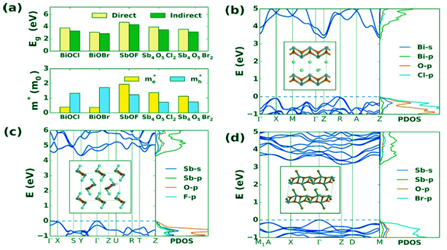 Bismuth and antimony-based oxyhalides and chalcohalides as potential optoelectronic materials(铋/锑基卤氧化物和硫卤化物作为潜在的光电材料)
Bismuth and antimony-based oxyhalides and chalcohalides as potential optoelectronic materials(铋/锑基卤氧化物和硫卤化物作为潜在的光电材料)
Zhao Ran, Xinjiang Wang, Yuwei Li, Dongwen Yang, Xin-Gang Zhao, Koushik Biswas, David J. Singh& Lijun Zhang
npj Computational Materials 4:14 (2018)
doi:10.1038/s41524-018-0071-1
Published online:22 March 2018
Abstract| Full Text | PDF OPEN
摘要:近十年来,ns2阳离子(如Pb2+和Sn2+)基卤化物(如混合钙钛矿太阳能吸收剂等)已成为最令人兴奋的新型光电材料之一。这些材料不仅在某些情况下表现出前所未有的性能,而且它们有可能以其出乎意料的性能(如对缺陷的极端耐受性)打开一片全新领域。然而,由于此类材料才刚出现不久,因此仍有很多化合物尚未得到充分探索。本研究采用连贯第一性原理法评价一系列铋/锑卤氧化物和硫卤化物,以确定其性质及其规律。基于这些计算,我们确定了一种由三种类型化合物组成的子集,有望用于太阳能吸收器、透明导体和辐射探测器。我们进一步探讨了它们的电子结构及其与晶体几何结构的关系,以及对带边扩散和载流子有效质量的影响。
Abstract:In the last decade the ns2 cations (e.g., Pb2+ and Sn2+)-based halides have emerged as one of the most exciting new classes of optoelectronic materials, as exemplified by for instance hybrid perovskite solar absorbers. These materials not only exhibit unprecedented performance in some cases, but they also appear to break new ground with their unexpected properties, such as extreme tolerance to defects. However, because of the relatively recent emergence of this class of materials, there remain many yet to be fully explored compounds. Here, we assess a series of bismuth/antimony oxyhalides and chalcohalides using consistent first principles methods to ascertain their properties and obtain trends.Based on these calculations, we identify a subset consisting of three types of compounds that may be promising as solar absorbers, transparent conductors, and radiation detectors.Their electronic structure, connection to the crystal geometry, and impact on band-edge dispersion and carrier effective mass are discussed.
Editorial Summary
Optoelectronics: new kids in town (光电子学:城里新来的孩子)
该研究以细致的第一性原理计算,揭示了铋基和锑基硫卤化物和卤氧化物在光电应用中的潜力。具有ns2的卤化物外层电子构型的离子,赋予卤化物光明的的应用前景(如太阳能电池)。该研究中,来自吉林大学、密苏里大学和阿肯色州立大学的科研人员,利用密度泛函理论研究了几种含铋或锑的ns2阳离子型硫卤化物和卤氧化物的性质。令人惊奇的是,某些铋基硫卤化物有望用于太阳能电池和室温辐射探测器,其带隙范围为1.5~2 eV。与此相对的是,一些带隙高于3eV卤氧化物是空穴导体,若可被掺杂,它们将可用作透明导电材料。该工作强调需要进一步的实验验证以充分评估该类材料在光电应用方面的潜力。
Detailed first-principles calculations reveal the potential of bismuth-based and antimony-based chalcohalides and oxyhalides for optoelectronics applications. The presence of ions with outer electron configuration of ns2in halides has rendered them very promising for applications, like solar cells.In this work, collaborators from Jilin University, University of Missouri, and Arkansas State University have used density functional theory to study the properties of several chalcohalides and oxyhalides containing bismuth or antimony ns2 cations.It turns out that certain bismuth-based chalcohalides are promising for solar cells applications and room-temperature radiation detectors, with bandgaps in the range 1.5–2 eV.Some oxyhalides, on the other hand, with bandgaps above 3 eV are hole-conducting, which makes them suitable for transparent conducting materials, if they can be doped. This work underlines that further experimental work is needed to fully assess the potential of this class of materials for optoelectronics applications.


 沪公网安备 31010502006565号
沪公网安备 31010502006565号